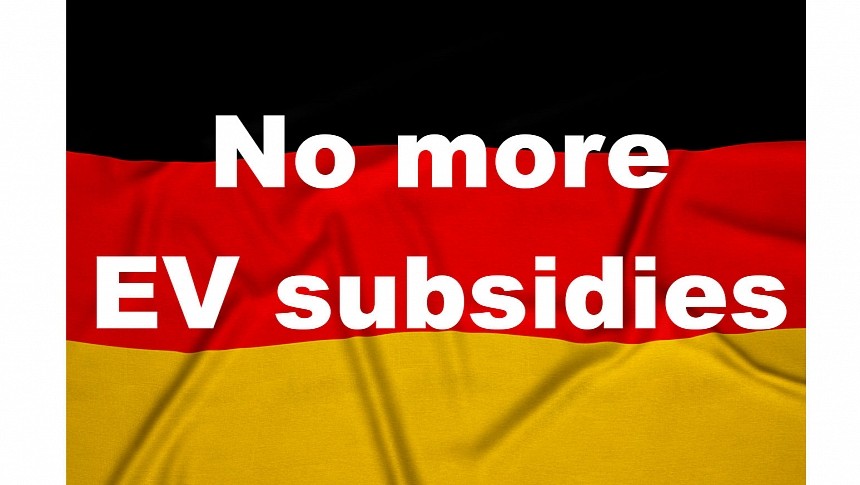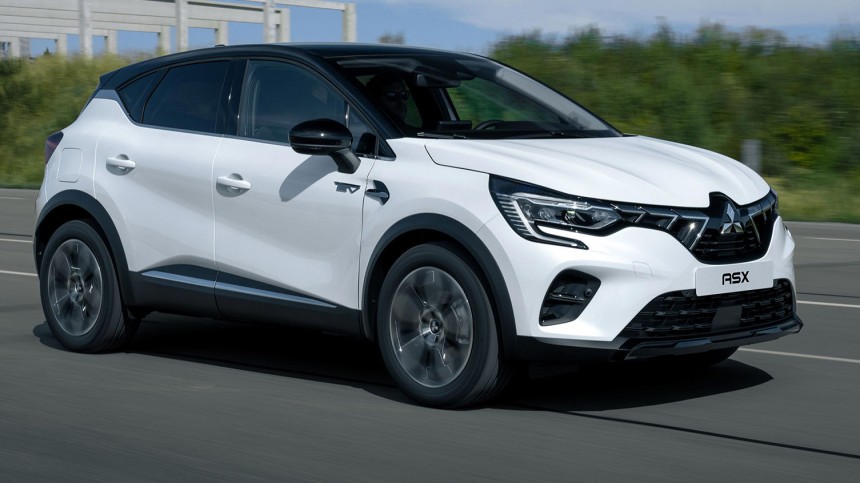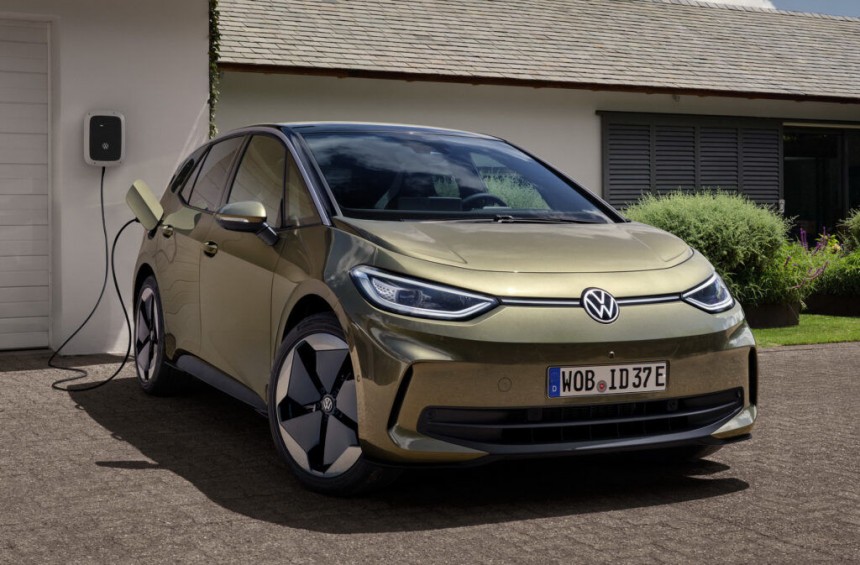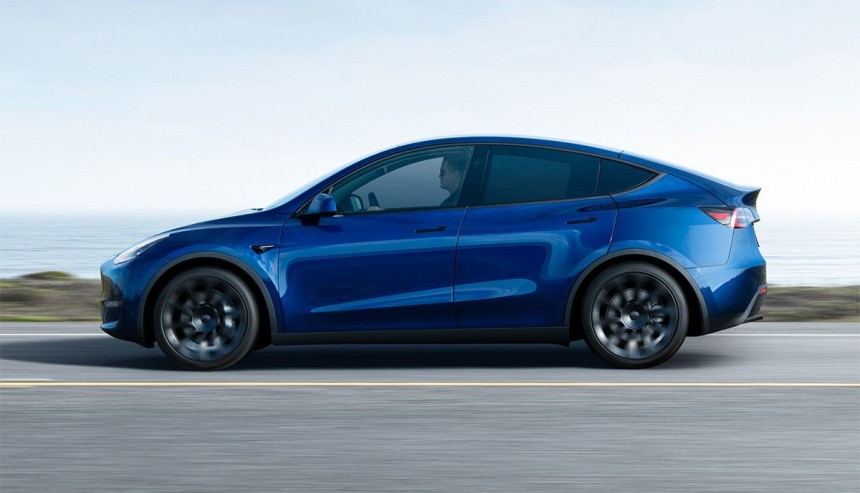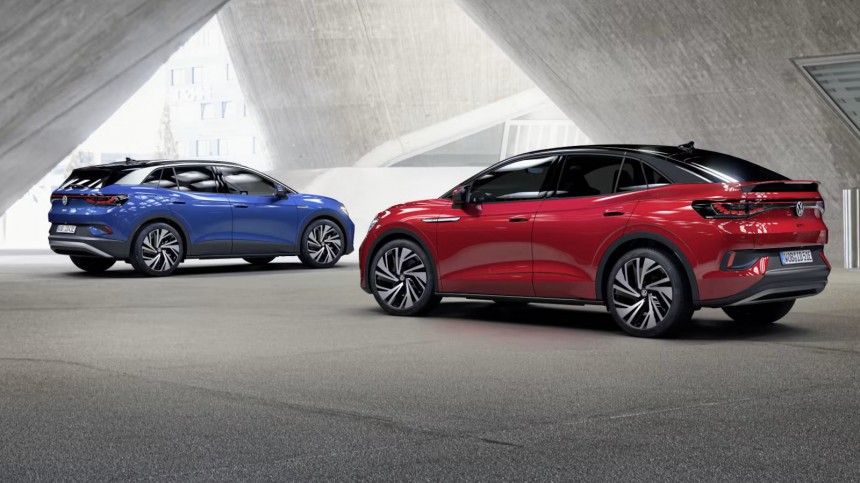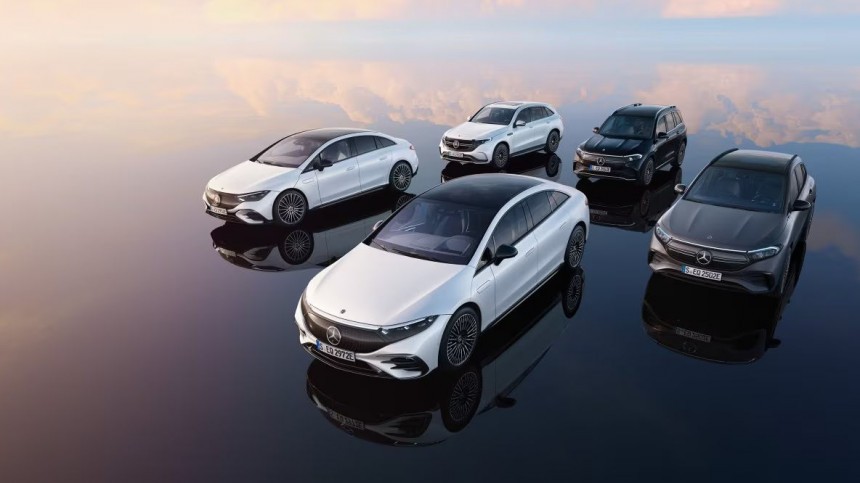Yes, ladies and gentlemen, the German government made an unexpected "present" to the car industry this December: it simply stopped the subsidies program for electric cars. It's not a joke or a conspiracy, but a move many analysts fear will blow up the transition to electromobility in the most prominent car market in the European Union. Unless…
To keep it short, the budget of the biggest economy on the European continent has a "hole" of around €60 billion / $66 billion. Budgetary cuts include the abrupt shutdown of the Umweltbonus EV subsidy program for 2024.
The bonus program came into effect in 2016. Since then, the German government has spent around €9.5 billion / $10.4 billion to subsidize 1.23 million pure electric cars, about 770,000 plug-in hybrids, and 400 hydrogen fuel cell cars.
The 2024 Umweltbonus was supposed to work only for pure EVs and have lower values. But now we can all agree that scrapping EV subsidies simply means goodbye to the bold objective of 15 million cars on German streets by 2030 – a third of the country's total car fleet.
Over the years, many voices warned about the "subsidies sand castle" that will eventually collapse. Many in the car industry feared the Umweltbonus distorted the car market and eliminating subsidies would lead to a crash in EV sales. Were they right? Or is the car market mature enough to thrive without the need for subsidies?
For pure electric cars costing up to €40,000 / $43,800, the total value was €6,750 / $7,400
- €4,500 / $4,930 were covered by the government
- €2,250 / $2,460 were covered by the car manufacturer
For pure electric cars between €40,000 / $43,800 and €65,000 / $71,200, the total value was €4,500 / $4,930
- €3,000 / $3,290 were covered by the government
- €1,500 / $1,650 were covered by the car manufacturer
Secondly, in 2024, the Umweltbonus' value was supposed to be lower (just €4,500 / $4,930) and apply only to pure electric cars costing up to €40,000 / $43,800
- €3,000 / $3,290 were covered by the government
- €1,500 / $1,650 were covered by the car manufacturer
This is harsh because most electric models on the European market today are more than forty grand. But this was part of the strategy to phase out subsidies, gradually lowering them yearly. At this point, I should note that in 2022, the Umweltbonus was more generous.
For pure electric cars costing up to €40,000 / $43,800, the total value was €9,000 / $9,900
- €6,000 / $6,600 were covered by the government
- €3,000 / $3,300 were covered by the car manufacturer
For pure electric cars between €40,000 / $43,800 and €65,000 / $71,200, the total value was €7,500 / $8,250
- €5,000 / $5,500 were covered by the government
- €2,500 / $2,750 were covered by the car manufacturer
Moreover, in 2022, there was also a "government discount" for plug-in hybrids, which amounted to between €3,700 / $4,050 and €4,500 / $4,930. In 2023, it was cut. As you can see, in just three years, the Umweltbonus was supposed to drastically but gradually reduce to favor more affordable pure electric cars.
So, does killing the Umweltbonus really mean killing the EV sales? Let's see some facts and figures.
As I told you earlier, the German government cut the subsidies for plug-in hybrids in 2023. As a result, plug-in hybrid car registrations were down 46% year-on-year. If I apply those experts' warnings, I find this very surprising: weren't they supposed to be near zero because of no subsidies?
Plug-in hybrids are generally expensive cars, and it's hard to find one under the €40,000 / $43,800 price tag. Today, the Mitsubishi ASX Plug-in Hybrid is among Germany's most affordable plug-in hybrids, with a discounted price of €34,890 / $38,250.
But you should know that, basically, Mitsubishi decided to "subsidize" this model because the starting price of €39,390 / $43,180 is quite unattractive for a compact SUV, which is nothing but a rebadged Renault Captur.
Another example is the KIA Ceed SW plug-in hybrid, with a starting price of €37,890 / $41,530. If the subsidies for plug-in hybrids were still in place, this model would probably cost around €34,000 / $37,300, just like the Mitsubishi ASX.
Compared to the somehow similar 1.5 T-GDI DCT petrol automatic variant (starting at €29,490 / $32,300) or to the 1.6 CRDi DCT diesel automatic variant (starting at €33,690 / $36,950), the subsidized plug-in variant would be an interesting option. But with no subsidies at all… you do the math.
Because of the high prices of plug-in hybrids, the public isn't necessarily lured by subsidies but by the promise of no "range anxiety" stress combined with low- or zero-emissions driving. Still, hybrids are a better alternative because they are less expensive and very close in terms of consumption and emissions.
While plug-in hybrid sales halved this year compared to 2022 (when they were subsidized), they still make up around 6% of the entire market share and 25% of the plug-in market share so far. The basic is this: scrapping subsidies led to slashing plug-in hybrids' sales in half. Now, will that be the case for EVs starting in 2024?
In the first 11 months, 469,500 electric cars were sold in Germany – basically the same as the whole 2022, when subsidies were more generous. December 2023 will probably mark another push from those who still want to benefit from some incentives.
While the German government closed the subsidies program on December 17, several carmakers decided to keep going with their share of those subsidies or even the entire subsidy. For instance, Volkswagen is willing to fund the total amount of €6,750 / $7,400 for those who ordered an ID. model before December 15.
For the VW ID. models registered between January 1 and March 31, 2024, the company will fund €4,500 / $4,930 – basically, the total subsidy that should have been in place in 2024. Audi, Mercedes-Benz, and Stellantis will also fund the full subsidy up to the end of 2023, and then they will offer some sort of discount in the first part of 2024.
Back to our numbers, shall we? So, in the first 11 months of 2023, sales of pure electric cars were up 28% compared to the same period in 2022. Wait, what? Despite lower subsidies by 25-40%, EV sales were up 28%. It's an interesting against-the-logic trend, don't you think, all you experts out there?
I should note that while the German car market has struggled since the pandemic, the EV market has thrived. In 2019, 3.6 million new cars were registered, and only 63,000 were electric, which is just 1.75% of the market share.
In 2022, around 2.65 million new cars were registered (so almost one million less than in 2019!), and more than 470,000 were 100% electric. This is more than 17% of the market share, or ten times better than four years ago. Did I hear someone in the back shouting, "S-curve, baby"?
The total number of electric cars sold for the full year 2023 will be a bit higher than last year but will probably not exceed the 500,000 units milestone. Still, the overall market increase is expected to be around 1% so that EVs will be close to 20% of the market share.
Many expect this to be the peak of EV sales in Germany now that the government scrapped the incentive program. Call me super-optimistic or just sorry-ass naive, but I doubt this means the EV market is doomed in Europe's most powerful economy.
They were followed by the chic Fiat 500 and – now that might be a surprise – by SUV brothers VW ID.4 and ID.5, which outclassed more affordable VW ID.3, Hyundai Kona, or Opel Corsa-e. Let's stick with it for a moment: more expensive EVs sold better.
In 2022, the Tesla Model Y was eligible for the €7,500 / $8,250 subsidy, so its basic price was around €38,000 / $41,700. The Tesla Model 3 was also suitable for that subsidy, so its starting price was closer to €35,000 / $38,500 threshold. Still, 1,500 more Model Ys were sold.
Is it weird or what? Actually, it's not. If you can afford around €40,000 / $43,800 for an electric car, you can most likely afford to pay a couple of grand extra for a supposedly much better car, right? I don't want to imply that SUVs are better than sedans, but this is the impact of intensive marketing on popular wisdom.
It's the same with VW ID.4 & ID.5 vs. their brother VW ID.3. The SUV variants had starting prices of less than €35,000 / $38,500 after subsidy, while the basic variant of the hatchback benefited from the €9,000 / $9,900 total subsidy, which made the ID.3 start from only €30,000 / $33,000. However, in 2022, around 1,500 more ID.4 and ID.5 were sold, just like in the case of Tesla.
Now, in 2023, I'll let you guess the best-seller so far. Of course, it was the Tesla Model Y! But get this: it's followed closely by direct rivals VW ID.4 and ID.5, which once again outclass the hatchback ID.3, which is very closely followed by its cousin Skoda Eniaq (the more spacious and more affordable ID.4, in short).
Model Y's starting price is more than €47,500 / $52,200; until now, it was eligible for a total subsidy of €4,500 / $4,950. So, the most affordable Y started from around €43,000 / $47,300. It's not that expensive, but it surely is not what most Germans would call affordable.
The VW ID.4 also starts from above €40,000 / $43,800, and thanks to the total subsidy of €4,500 / $4,950, its price was lowered to some €36,000 / $39,600. The VW ID.3 starts just below €40,000 / $43,800, so it benefited from the total €6,750 / $7,450 – this way, its basic price was less than €33,000 / $36,300.
Up to this point, the difference between the SUV siblings and the hatchback is more than 10,000 units in favor of ID.4 and ID.5, although the ID.3 is less expensive. And don't forget that Skoda Eniaq is almost as sold as the ID.3, despite a €44,000 / $48,400 starting price, which became around €39,000 / $42,900 thanks to the €4,500 / $4,950 subsidy.
This means the €4,500 / $4,950 subsidy equaled less than 10% of the car's value. One interesting remark: EVs costing more than €65,000 / $71,500 didn't benefit from any kind of subsidy. Still, their sales, while not impressive in terms of units, remained almost constant throughout the year.
While I'm not a fortune teller, I think this will most likely be the case with EVs costing more than €40,000 / $43,800. That's because the parity price of EVs with plug-in hybrids or even ICE-comparable cars is already in favor of EVs.
However, the big problem of scrapping all EV subsidies will most likely affect the segment of electric vehicles costing less than €40,000 / $43,800. European manufacturers are ill-prepared in that regard, and cheap EVs are still far away – at least, with no help from subsidies whatsoever.
German premium brands will hardly be affected by scrapping the Umweltbonus. In the first 11 months of 2023, Mercedes-Benz, Audi, and BMW sold almost 95,000 electric cars together –20% of total EV sales this year in Germany. Of course, these are EVs priced over the €40,000 / $43,800 mark, so their customers can afford to live without the subsidies.
This also applies to Tesla (almost 60,000 units sold year-to-date), Volkswagen (nearly 65,000 units), Hyundai (more than 26,000 units), KIA (almost 14,000 units) or Skoda (20,000 units). In fact, more than half of the EV market in Germany is made of expensive cars.
So, in the worst-case scenario, scrapping EV subsidies will most likely lead to halving sales in 2024. But remember that many car makers are willing to pay the subsidy cost, at least in the first months of the following year. This will temper the cooling of EV sales, and, in the meantime, the government could be persuaded to reinstate some form of Umweltbonus.
I know that's just wishful thinking, but I can't underestimate the car industry's power over politics – the best example is recent e-fuel propaganda. Besides, the Chinese EV invasion is another strong argument for the German government to try to protect its own EV industry. Which has already invested tens of billions of euros into battery manufacturing sites and R&D centers meant to speed up the development of much better EVs.
Ultimately, I can only say that Germany's case is a historical moment for the rEVolution. If EV sales will not drop too harshly – they will drop, that's for sure – then the transition to electromobility will keep going. Not at a fast pace, as hoped, but building momentum and becoming a valid alternative to conventional cars.
What if EV sales will crash in Germany because of scrapping subsidies? While I don't believe such a scenario is possible anymore, I agree there's some statistical risk for this to happen. In that case, you can kiss the European car industry goodbye because relying on ICEs means we are doomed, while subsidizing hydrogen is much more costly than subsidizing electromobility. Germany can't afford this lose-lose scenario.
The bonus program came into effect in 2016. Since then, the German government has spent around €9.5 billion / $10.4 billion to subsidize 1.23 million pure electric cars, about 770,000 plug-in hybrids, and 400 hydrogen fuel cell cars.
The 2024 Umweltbonus was supposed to work only for pure EVs and have lower values. But now we can all agree that scrapping EV subsidies simply means goodbye to the bold objective of 15 million cars on German streets by 2030 – a third of the country's total car fleet.
Over the years, many voices warned about the "subsidies sand castle" that will eventually collapse. Many in the car industry feared the Umweltbonus distorted the car market and eliminating subsidies would lead to a crash in EV sales. Were they right? Or is the car market mature enough to thrive without the need for subsidies?
How much was the Umweltbonus, anyway?
Firstly, this is how Umweltbonus worked: the government covered two-thirds of the subsidy amount, while the car manufacturer covered one-third. For instance, in 2023, the Umweltbonus' value was divided like this:For pure electric cars costing up to €40,000 / $43,800, the total value was €6,750 / $7,400
- €4,500 / $4,930 were covered by the government
- €2,250 / $2,460 were covered by the car manufacturer
For pure electric cars between €40,000 / $43,800 and €65,000 / $71,200, the total value was €4,500 / $4,930
- €3,000 / $3,290 were covered by the government
- €1,500 / $1,650 were covered by the car manufacturer
Secondly, in 2024, the Umweltbonus' value was supposed to be lower (just €4,500 / $4,930) and apply only to pure electric cars costing up to €40,000 / $43,800
- €3,000 / $3,290 were covered by the government
- €1,500 / $1,650 were covered by the car manufacturer
This is harsh because most electric models on the European market today are more than forty grand. But this was part of the strategy to phase out subsidies, gradually lowering them yearly. At this point, I should note that in 2022, the Umweltbonus was more generous.
For pure electric cars costing up to €40,000 / $43,800, the total value was €9,000 / $9,900
- €6,000 / $6,600 were covered by the government
- €3,000 / $3,300 were covered by the car manufacturer
For pure electric cars between €40,000 / $43,800 and €65,000 / $71,200, the total value was €7,500 / $8,250
- €5,000 / $5,500 were covered by the government
- €2,500 / $2,750 were covered by the car manufacturer
Moreover, in 2022, there was also a "government discount" for plug-in hybrids, which amounted to between €3,700 / $4,050 and €4,500 / $4,930. In 2023, it was cut. As you can see, in just three years, the Umweltbonus was supposed to drastically but gradually reduce to favor more affordable pure electric cars.
So, does killing the Umweltbonus really mean killing the EV sales? Let's see some facts and figures.
An example of plug-in hybrids: with no subsidies, sales slashed in half
In the first 11 months of 2023, Germans bought more than 627,000 new plug-in cars – almost 470,000 were full-electric vehicles, while the rest were plug-in hybrids (less than 160,000).As I told you earlier, the German government cut the subsidies for plug-in hybrids in 2023. As a result, plug-in hybrid car registrations were down 46% year-on-year. If I apply those experts' warnings, I find this very surprising: weren't they supposed to be near zero because of no subsidies?
But you should know that, basically, Mitsubishi decided to "subsidize" this model because the starting price of €39,390 / $43,180 is quite unattractive for a compact SUV, which is nothing but a rebadged Renault Captur.
Another example is the KIA Ceed SW plug-in hybrid, with a starting price of €37,890 / $41,530. If the subsidies for plug-in hybrids were still in place, this model would probably cost around €34,000 / $37,300, just like the Mitsubishi ASX.
Compared to the somehow similar 1.5 T-GDI DCT petrol automatic variant (starting at €29,490 / $32,300) or to the 1.6 CRDi DCT diesel automatic variant (starting at €33,690 / $36,950), the subsidized plug-in variant would be an interesting option. But with no subsidies at all… you do the math.
Because of the high prices of plug-in hybrids, the public isn't necessarily lured by subsidies but by the promise of no "range anxiety" stress combined with low- or zero-emissions driving. Still, hybrids are a better alternative because they are less expensive and very close in terms of consumption and emissions.
While plug-in hybrid sales halved this year compared to 2022 (when they were subsidized), they still make up around 6% of the entire market share and 25% of the plug-in market share so far. The basic is this: scrapping subsidies led to slashing plug-in hybrids' sales in half. Now, will that be the case for EVs starting in 2024?
Smaller subsidies didn't force the slashing of EV sales
In 2022, around 470,000 electric vehicles were sold in Germany, with a push in November and December because of the announcement of subsidies trimming for 2023. So, what happened in 2023 so far?In the first 11 months, 469,500 electric cars were sold in Germany – basically the same as the whole 2022, when subsidies were more generous. December 2023 will probably mark another push from those who still want to benefit from some incentives.
While the German government closed the subsidies program on December 17, several carmakers decided to keep going with their share of those subsidies or even the entire subsidy. For instance, Volkswagen is willing to fund the total amount of €6,750 / $7,400 for those who ordered an ID. model before December 15.
Back to our numbers, shall we? So, in the first 11 months of 2023, sales of pure electric cars were up 28% compared to the same period in 2022. Wait, what? Despite lower subsidies by 25-40%, EV sales were up 28%. It's an interesting against-the-logic trend, don't you think, all you experts out there?
I should note that while the German car market has struggled since the pandemic, the EV market has thrived. In 2019, 3.6 million new cars were registered, and only 63,000 were electric, which is just 1.75% of the market share.
In 2022, around 2.65 million new cars were registered (so almost one million less than in 2019!), and more than 470,000 were 100% electric. This is more than 17% of the market share, or ten times better than four years ago. Did I hear someone in the back shouting, "S-curve, baby"?
The total number of electric cars sold for the full year 2023 will be a bit higher than last year but will probably not exceed the 500,000 units milestone. Still, the overall market increase is expected to be around 1% so that EVs will be close to 20% of the market share.
Many expect this to be the peak of EV sales in Germany now that the government scrapped the incentive program. Call me super-optimistic or just sorry-ass naive, but I doubt this means the EV market is doomed in Europe's most powerful economy.
More expensive EVs sell better than their more affordable siblings
Let's get back to 2022 and take a look at the best-selling EVs in Germany. The top spot is Tesla, with almost 70,000 cars sold. The Best-seller was naturally the Tesla Model Y, followed by – don't hold your breath – its sibling Model 3.They were followed by the chic Fiat 500 and – now that might be a surprise – by SUV brothers VW ID.4 and ID.5, which outclassed more affordable VW ID.3, Hyundai Kona, or Opel Corsa-e. Let's stick with it for a moment: more expensive EVs sold better.
Is it weird or what? Actually, it's not. If you can afford around €40,000 / $43,800 for an electric car, you can most likely afford to pay a couple of grand extra for a supposedly much better car, right? I don't want to imply that SUVs are better than sedans, but this is the impact of intensive marketing on popular wisdom.
It's the same with VW ID.4 & ID.5 vs. their brother VW ID.3. The SUV variants had starting prices of less than €35,000 / $38,500 after subsidy, while the basic variant of the hatchback benefited from the €9,000 / $9,900 total subsidy, which made the ID.3 start from only €30,000 / $33,000. However, in 2022, around 1,500 more ID.4 and ID.5 were sold, just like in the case of Tesla.
Now, in 2023, I'll let you guess the best-seller so far. Of course, it was the Tesla Model Y! But get this: it's followed closely by direct rivals VW ID.4 and ID.5, which once again outclass the hatchback ID.3, which is very closely followed by its cousin Skoda Eniaq (the more spacious and more affordable ID.4, in short).
Model Y's starting price is more than €47,500 / $52,200; until now, it was eligible for a total subsidy of €4,500 / $4,950. So, the most affordable Y started from around €43,000 / $47,300. It's not that expensive, but it surely is not what most Germans would call affordable.
The VW ID.4 also starts from above €40,000 / $43,800, and thanks to the total subsidy of €4,500 / $4,950, its price was lowered to some €36,000 / $39,600. The VW ID.3 starts just below €40,000 / $43,800, so it benefited from the total €6,750 / $7,450 – this way, its basic price was less than €33,000 / $36,300.
EVs are going to stay, with or without subsidies
So, the bestsellers in the German EV arena are cars with basic prices over €40,000 / $43,800. But don't be fooled by this – the more affordable variants have smaller battery capacities. Most customers opted for higher-capacity battery variants, usually at least €50,000 / $55,000.This means the €4,500 / $4,950 subsidy equaled less than 10% of the car's value. One interesting remark: EVs costing more than €65,000 / $71,500 didn't benefit from any kind of subsidy. Still, their sales, while not impressive in terms of units, remained almost constant throughout the year.
While I'm not a fortune teller, I think this will most likely be the case with EVs costing more than €40,000 / $43,800. That's because the parity price of EVs with plug-in hybrids or even ICE-comparable cars is already in favor of EVs.
However, the big problem of scrapping all EV subsidies will most likely affect the segment of electric vehicles costing less than €40,000 / $43,800. European manufacturers are ill-prepared in that regard, and cheap EVs are still far away – at least, with no help from subsidies whatsoever.
German premium brands will hardly be affected by scrapping the Umweltbonus. In the first 11 months of 2023, Mercedes-Benz, Audi, and BMW sold almost 95,000 electric cars together –20% of total EV sales this year in Germany. Of course, these are EVs priced over the €40,000 / $43,800 mark, so their customers can afford to live without the subsidies.
This also applies to Tesla (almost 60,000 units sold year-to-date), Volkswagen (nearly 65,000 units), Hyundai (more than 26,000 units), KIA (almost 14,000 units) or Skoda (20,000 units). In fact, more than half of the EV market in Germany is made of expensive cars.
I know that's just wishful thinking, but I can't underestimate the car industry's power over politics – the best example is recent e-fuel propaganda. Besides, the Chinese EV invasion is another strong argument for the German government to try to protect its own EV industry. Which has already invested tens of billions of euros into battery manufacturing sites and R&D centers meant to speed up the development of much better EVs.
Ultimately, I can only say that Germany's case is a historical moment for the rEVolution. If EV sales will not drop too harshly – they will drop, that's for sure – then the transition to electromobility will keep going. Not at a fast pace, as hoped, but building momentum and becoming a valid alternative to conventional cars.
What if EV sales will crash in Germany because of scrapping subsidies? While I don't believe such a scenario is possible anymore, I agree there's some statistical risk for this to happen. In that case, you can kiss the European car industry goodbye because relying on ICEs means we are doomed, while subsidizing hydrogen is much more costly than subsidizing electromobility. Germany can't afford this lose-lose scenario.
